Art of a Generation
Ron Morosan
March 2019
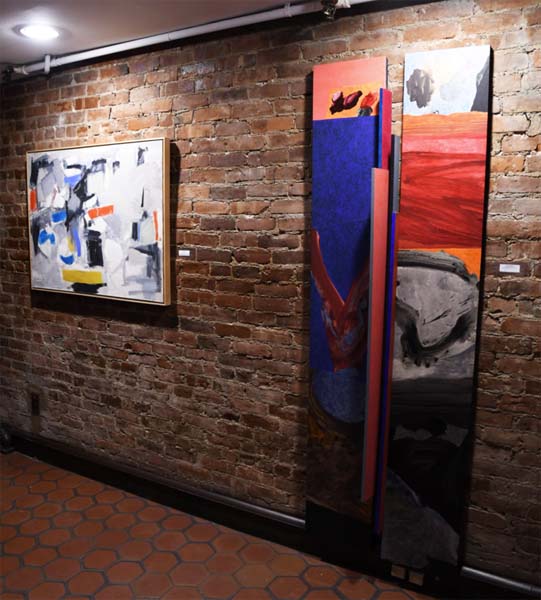 Joseph Fiore, Erie, 1955, oil on canvas, 30″ x 40″
Joseph Fiore, Erie, 1955, oil on canvas, 30″ x 40″
William Manning, Atlantic Series #63, oil varnish on wood, 76.75″ x 51″ x 6.75″
Abstract Schmabstract
Altered Edges
On arriving at the Anita Shapolsky Gallery and walking a step down to a big red open grid metal door on the lower level, a distinct feeling that this is a kind of speakeasy came over me. The gallery is located on two lower floors of a classic turn of the century brick townhouse. Inside the feeling is comfortable and homey, and on every wall paintings are hanging.
On view now are two shows: Abstract Schmabstract and Altered Edges featuring Richards Ruben. Abstract Schmabstract on the first floor is a group show of artists that Shapolsky has represented for many years: Seymour Boardman, Ernest Briggs, Lawrence Calcagno, Joseph Fiore, Buffie Johnson, William Manning, Ethel Schwabacher, Thomas Sills, Amaranth Ehrenhalt, and Ilya Bolotowsky. Upstairs on the second floor is a one person show of Richards Ruben.
The title Abstract Schmabstract at first sounds humorous, as if “Schmabstract” is implying a comic Yiddish Theatre question where the comic throws up both hands in a gesture of “Who knows?” But the title has a double meaning: the “schma” term comes from “Shema” in Deuteronomy where a daily prayer is elicited, “Hear O Israel: the LORD our God is one,” a command that we are to hear God effectively.
Most of the artists in this exhibition are considered by art historians to be second generation abstract expressionist, except for Bolotowsky whose work comes out of a Neo-Plastic source and a general European geometric tradition.
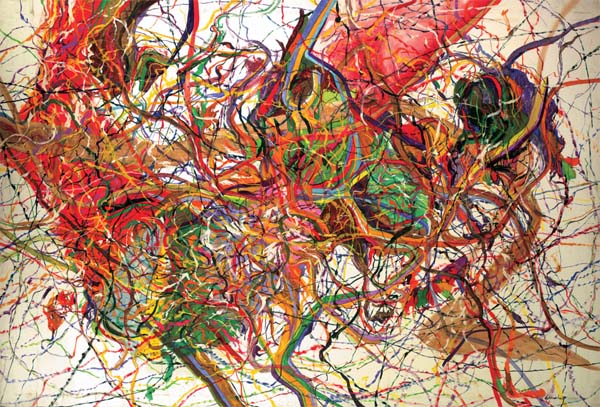 Amaranth Ehrenhalt, Umatilla, 1959, oil on canvas, 59″ x 87″
Amaranth Ehrenhalt, Umatilla, 1959, oil on canvas, 59″ x 87″
What does it mean to be a second generation abstract expressionist? The first thing we have to consider is that these artists have taken up the torch of the first generation, or the prime movers who are now associated with the canon of Abstract Expressionism. The most prominent of that group are de Kooning, Pollock, Rothko, et al. However, what distinguishes the second generation are aspects of a particular subjectivity, or personal approach to their painting. While de Kooning is the most European of the Abstract Expressionist school, we can see his influence on most of the artists on exhibit here. Ernest Briggs, Ethel Schwabacher and Amaranth Ehrenhalt are painters who paint abstractly from an experience, in the de Kooning sense, rather than painting from a Pollock approach where the paint is applied in a formal setting of pragmatic materiality motivated by an automatism
Briggs’ large Untitled Diptych from 1953 is a masterful example of abstracting from an experience of something in the world: a street scene, a landscape, but with no particular reference. It fulfills the definition of expressed feeling and the sense of being in the world. With wide gestures of palette knife using yellow, red, white, and black, Briggs establishes an arena of painted space where the viewer meets the painter’s sensibility directly.
Another characteristic of second generation painters is that they have studied with some of the first generation artists: such is the case with Ernest Briggs who studied with Clyfford Still, and Joseph Fiore who studied with de Kooning.
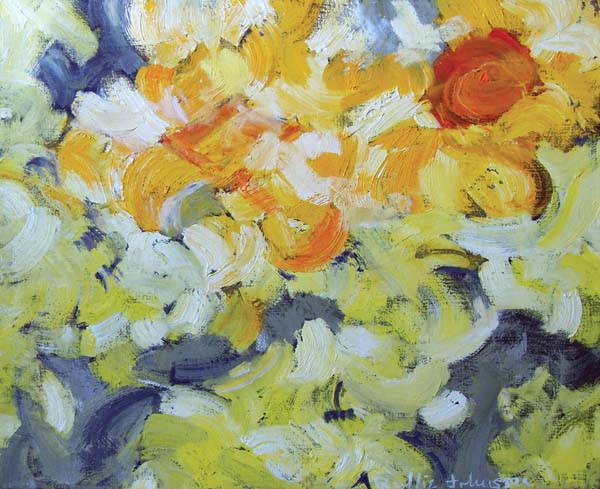 Buffie Johnson, Cyclical Time 1, 1962, oil on canvas, 21″ x 24″
Buffie Johnson, Cyclical Time 1, 1962, oil on canvas, 21″ x 24″
Fiore’s painting Erie, 1955 is a study in red, white, and blue structured in a complex spatial matrix of grey that is almost cubist in its organization. The free ease of the brushwork is equal to any de Kooning of the same period.
Buffie Johnson has a close affinity with Fiore in her systematic filling of the space of the canvas in Cyclical Time 3 of 1962. Round globe-like brushstrokes create a nebulous aura of space and color.
Amaranth Ehrenhalt spent thirty formative years living and working in France and Italy, therefore qualifying her as much a European artist as an American. What distinguishes her painting is her subjective experimentation with paint and composition. In Umatilla of 1959 an allover web of painted lines might at first call to mind a drip canvas by Pollock, but Ehrenhalt is painting every line, not pouring. Her painting has a look that is very contemporary and should be compared with new millennial artists showing on the Lower East Side or Brooklyn. Born in 1928, she still paints like a young artist.
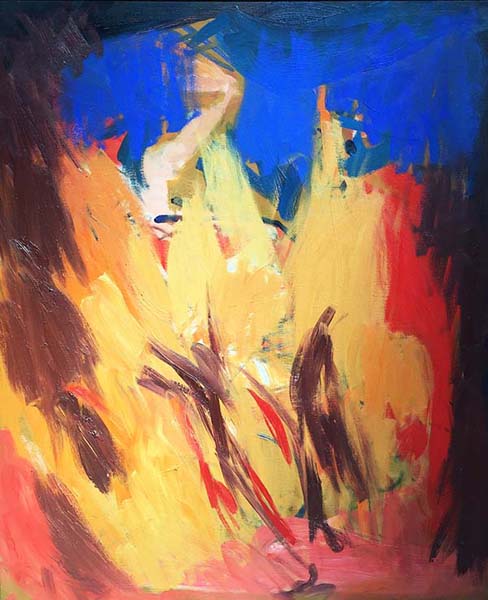 Ethel Schwabacher,Warm Rain II, 1959, Oil on Canvas, 50″ x 40″
Ethel Schwabacher,Warm Rain II, 1959, Oil on Canvas, 50″ x 40″
Ethel Schwabacher, Thomas Sills, and Lawrence Calcagno take the language of Abstract Expressionism into an almost private direction. In Sill’s painting Summer, 1950, he creates a shallow illusionary space that seems to project about twelve inches into the canvas surface; in this yellow-toned space a seething realm of bio-forms undulate and squeeze together. A sense of intense emotion is created and then disguised with opaque phantasmagoric forms.
With Schwabacher’s painting Warm Rain II, 1959, a very different approach is taken, but one no less intense. In a field of dark ultramarine blue, flamelike forms come up from the lower region in a freely brushed development creating a sense of lift. In this half-formed space the composition begs the viewer to complete it.
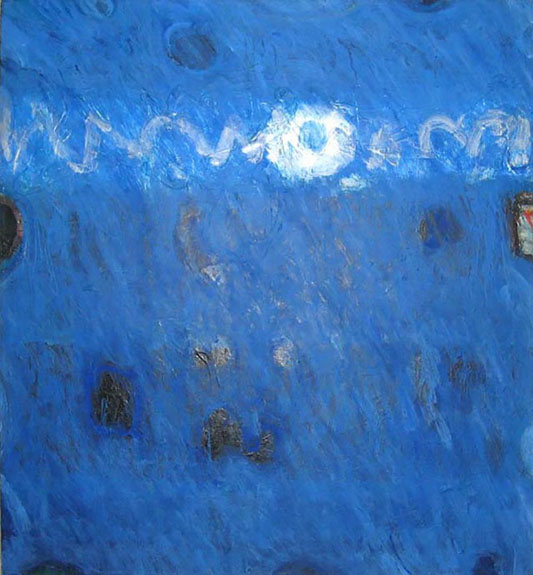 Lawrence Calcagno, Blue Painting, 1975, acrylic on canvas, 52″ x 48″
Lawrence Calcagno, Blue Painting, 1975, acrylic on canvas, 52″ x 48″
Lawrence Calcagno evokes a similar private approach in his work Blue Painting, 1971. Here a suggestion of a seascape is evident, but one in which a doughnut- like form across the top is made to appear in motion with a linear suggestion of line on either side. Calcagno turns the language of abstraction into something that addresses the world around him, and makes the viewer aware that nature is at the root of his intention.
William Manning and Ilya Bolotowsky occupy a constructive mode of their own in this exhibition, but one which addresses abstraction in the subjective sense as well. While Bolotowsky directly references Neo-Plasticism in the vertical and horizontal composition, he transforms the surface in a way that moves away from the catechism of that doctrinal movement. His composition Naples Yellow and Grey,1958, recalls a Mediterranean light and a subjective moment where structure is captured in a moment of being.
In his work Atlantic Series 63, 1993, William Manning literally constructs models of constructive abstraction and then paints space into them. This three dimensional form of painting is inventive and partakes of a staging of abstraction that is prescient of what will become a much more installational art in the hands of the younger generation.
Seymour Boardman is singular in this exhibition with his black and white painting Untitled, 1971. With a mood that could stand in for a Samuel Beckett play announcement poster, Boardman declares himself an existentialist as artist. Black forms emerge from the sides and top of this canvas and where they almost meet a slashing line is presented that could suggest something about to happen, but we will never know what.
The role of the subconscious in the history of Abstract Expressionism has been given little attention as to its role in the content of this movement. Very early in the late forties and early fifties the term Abstract Surrealism was used. But then art critics and historians got rid of the term Surrealism because it was too unknown and also too European. Settling on Abstract Expressionism gave more room for formal interpretation and a more American take on how to negotiate preferred content. But the subconscious is the huge reservoir of psychic energy that determines much in life and culture. If we accept the French psychoanalyst Lacan’s theories, that the subconscious is a structured language, then the subconscious content of Abstract Expressionism may have more to do with a psychological and even a philosophical content.
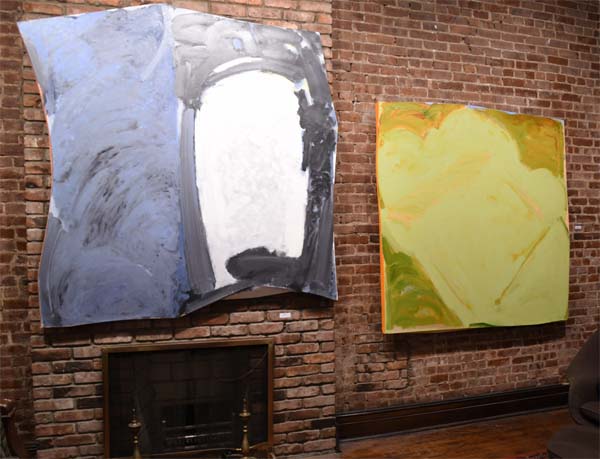 Richards Ruben, oil on canvas, At Place, 1993, 70″ x 70″, Black Painting 1, 80″ x 42″
Richards Ruben, oil on canvas, At Place, 1993, 70″ x 70″, Black Painting 1, 80″ x 42″
On the second floor the one-person exhibition of paintings and collages by Richards Ruben is a hybrid of the Abstract Expressionist language. This selection titled Altered Edges brings direct attention to Ruben’s unusual shaping and changing the edges of a rectangular canvas. This subtle altering produces an almost vertiginous experience where the viewer is placed in a situation where horizontal and vertical are difficult to determine. The wall and space around the painting become part of the work and an installation-like situation is suggested. His work Edgewise of 1989 is one of the best examples of his approach. A large canvas that is placed on a wall separate from the rest of the gallery, its surface seems to move in and out as the eye scans the edge of the canvas and takes in the large blue form at the right. Thoughts that come to mind in this work suggest a connection to the theory of Gestalt perceptual psychology espoused by Rudolph Arnheim. In his book Art and Visual Perception Arnheim analyses how our perceptual system is specialized to take in what we see in specific contexts of awareness. The various parts of a rectangle have perceptual equivalents in our eye and when we perceive forms in a particular part of a picture they register in our psyche in specific ways. Applying this kind of thinking to Ruben would put him in the company of certain Minimal artists like Robert Ryman and Robert Irwin, and thus account for the hybrid quality of this group of paintings in a context that is conceptual and theoretical.
Considering second generation artists we could ask the question: what good is art history? It gives us categories and labels in which to place art; it gives us explanatory narratives to tell the story of painting and sculpture. But it can compartmentalize art in ways that make it difficult to experience art in a unbiased condition. Second generation is one of those labels. We can ask another question: Who was the second person to fly solo across the Atlantic? We all know the first. The second person was Amelia Earhart. She was a woman, she had more to overcome, and, as we later found out, she took more risks.
All images courtesy of Anita Shapolsky Gallery
Abstract Schmabstract
Altered Edges
January 19-April 9, 2019
Anita Shapolsky Gallery
152 East 65th Street New York, NY
◊
Ron Morosan is an artist, writer, and curator. He has shown his work internationally at the American Pavilion of The Venice Biennale and the Circulo De Bellas Artes in Madrid, Spain. In the US he has shown at the New Museum and had a one-person exhibition at the New Jersey State Museum, and at numerous galleries in New York. He curated the Robert Dowd exhibition, Subversive Pop, at Center Galleries in Detroit, as well as Denotation, Connotation, Implication at Eisner Gallery, City University of New York. He has written catalogues for many artists, including Enid Sanford, Tom Parish, Robert Dowd, and others. In the 1990’s he started and ran B4A Gallery in Soho, New York, writing press releases, articles, and catalogues.
